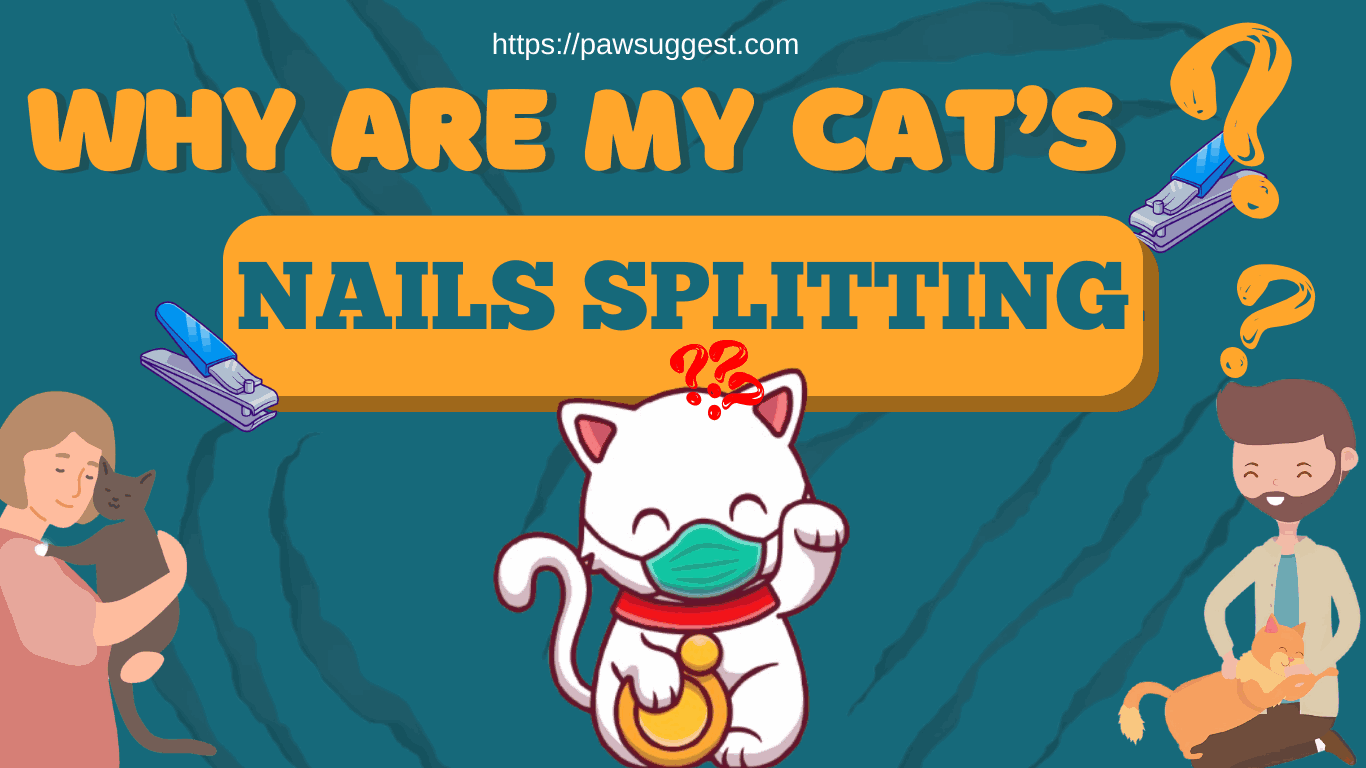Have you ever found tiny bits and pieces of your cat’s nails around the house, leaving you worried? As a concerned pet parent, you might be wondering why this is happening and whether it’s normal or a concern that needs vet attention.
Cats regularly shed the outer layers of their nails, and this process is completely normal. They typically remove the old claw-shaped layer by scratching on something, revealing a sharp, shiny new claw beneath.
However, splitting can also be due to potential causes like thin, misshapen nails, which may require a vet’s attention no matter whether it’s happening before or after a pet bathing session.

Why Are My Cat’s Nails Splitting? Causes, Prevention & When to See a Vet
Cats’ nails split naturally as they shed old layers, revealing new claws. However, overgrown nails, aging, improper trimming, poor diet, or health issues like infections and arthritis can worsen splitting.
Providing scratching posts, regular trims, and proper nutrition helps prevent problems. Severe splits causing pain or bleeding require veterinary care to avoid infections and discomfort.
11 Potential Reasons Why Your Cat’s Nails are Splitting
Cats naturally experience the shedding of their nails as they grow. The old layer starts splitting, making room for a new one. On average, this happens every two to three months as the claw splits and falls off. If your cat is frequently scratching, it may speed up this process, helping the old layers come off without issues.

1. Old Layers
Cats’ nails go through a natural shedding process. Every two to three months, the old layer peels off, allowing a new claw to take place. This is actually normal and doesn’t always require vet attention unless you notice excessive splitting or discomfort.
2. Overgrown Nails
When nails grow past their natural length, they can become overgrown, making it harder for your cat to use scratching posts or the litter box. This neglect can lead to split ends, discomfort, and an increased risk of cracks or breaks.
- Overgrown nails may cause difficulty walking.
- Avoiding scratching posts is a sign of pain.
- Trimming is critical to prevent splitting.
3. Aging
As your cat ages, its claws may become thicker and tougher, but also more prone to splitting. This is a common part of the aging process. Senior cats may need more frequent nail trims to prevent discomfort.
4. Osteoarthritis
Degenerative joint diseases like osteoarthritis can reduce movement, making it harder for your cat to scratch. This lack of activity may cause nails to become overgrown or split. Bone spurs and cartilage degradation may lead to pain when scratching.
5. Improper Nail Trimming
Using blunt clippers applies too much pressure, causing the nail to crack instead of making a clean trim. People using improper tools may unintentionally injure their cat’s paws, leading to bleeding or infection. Introducing a proper trimming routine early is critical.
6. Chronic Biting And Grooming Issues
Some cats chew or bite their nails due to anxiety, stress, or grooming habits. If this happens excessively, it may signal an underlying condition like ringworm, fungal infections, or skin irritation. Watch for signs like red paws, dandruff, or intense scratching.
7. Poor Health
Certain chronic health issues affect nail conditions. If your cat’s nails split frequently, it may be due to nutritional deficiencies affecting protein, muscle, tendons, or ligaments. A full coat or skin issues may also be linked to poor nutrition.
8. Traumatic Injuries And Broken Nails
A cat may get its claws stuck in objects like carpets, scratching posts, or toys. Forcefully pulling free can lead to nail splitting, cracks, or even complete loss of the claw. Bad landings from high jumps may also result in traumatic injury.
9. Nailbed Disorders
Onycholysis (nail separating from underlying structures) can occur due to bacterial, viral, or fungal infections. Tumors, though uncommon, can also cause nail splitting. If you notice abnormal growth, monitor your cat’s claws closely and seek a vet examination.
10. Natural Cycle
Cats’ nails have an outer layer that sheds naturally. The first few layers fall off, revealing a sharp edge. If your cat is not scratching enough, the nails may split unevenly instead of peeling smoothly.
11. Wrong Nail Clipper
Using the wrong clippers or not trimming regularly can lead to messy splitting. Keep a sharp, clean pair of clippers and trim the excess length without cutting too deep. Be cautious to avoid hitting the internal blood supply (quickly), as this can cause bleeding.
Tips for Healthy Nails
- Trim regularly to prevent overgrown nails.
- Provide scratching posts to aid in natural shedding.
- Watch for frequent nail splits as a sign of health issues.
- Examine paws daily for signs of injuries, infections, or splitting.
- Seek vet advice if your cat’s nails seem brittle, painful, or frequently breaking.
Is Your Cat’s Nails Splitting a Serious Issue?
A cat with a split or broken nail can feel intense pain, making walking, jumping, and playing difficult. A cracked nail is not just uncomfortable, it can turn into a bigger problem if ignored. Your furry friend may struggle with mobility, favoring one paw and avoiding putting weight on it.
Why Your Cat’s Nails Splitting Can Be a Serious Issue?
Risk of Infection
A torn nail often leads to bleeding, creating an open wound that invites bacteria. Without proper medical attention, an infection can develop, affecting the surrounding tissue and causing further damage. If left untreated, it may require stronger treatments to clear up the issue.
Behavioral Changes
Pain can cause behavioral changes, making your cat irritable, agitated, or withdrawn from social interactions. In an attempt to groom, they might accidentally scratch themselves with the sharp, jagged edge of the injured nail, leading to further self-injury.
- Frustration from limited mobility can make them less active.
- The sharp nail can hurt other body parts.
- If your cat is bothering their paw too much, a vet visit is essential.
If your cat is experiencing a split nail, quick veterinarian care is crucial to prevent complications. A vet may provide pain medication to relieve discomfort and ensure the nail is properly fixed. Seeking care early can help your furry friend recover quickly and restore their well-being.
What To Do If Your Cat’s Nails are Splitting?
Handle With Care When Treating Split Nails
If a cat’s nail splits, it may react unpredictably due to pain. Restrain it gently using a towel for comfort and safety. Having a family friend assist can help secure your feline to prevent scratching or biting.
Control Bleeding With Proper First-Aid
If the nail is bleeding, use a gauze pad and apply pressure to the affected paw for 5 to 10 minutes. If it continues, use a styptic pencil, silver nitrate stick, or cauterizing powder from pet stores or a pharmacy. Baking flour can act as a temporary clotting agent.
Remove Only the Loose Portion
Never attempt to remove an attached layer yourself. If a portion of the nail is uncomfortable, trim it carefully with clippers. The remaining base will regrow naturally. For severe cases, seek veterinary care to prevent infection.
Protect the Nail Bed From Infection
After trimming, clean the affected area with antibiotic ointment and apply a bandage to avoid contamination. In severe instances, a vet may prescribe oral or injectable medication to combat complications that could reach the bone.
Seek Veterinary Care for Persistent Issues
If your cat frequently experiences nail splitting, a checkup can rule out underlying health conditions. A veterinarian may perform advanced diagnostics to determine the cause and suggest the most effective treatment.
Make Nail Trimming Easier With Help
To make the nail-trimming session a success, enlist a friend or family member. Place your kitty on a slick surface, gently press the toe to extract the toenail, and trim the sharp tip carefully. Over time, your furry friend will get used to the routine.
Tips to Prevent Your Cat’s Nails from Splitting
Keeping your cat’s nails in good shape is important. If they are not trimmed properly, they may split, causing pain and discomfort. Here are some simple ways to prevent splitting and keep your furry friend happy.
Use Proper Nail-Trimming Techniques
- Trim your cat’s nails regularly to maintain the right length and avoid injuries.
- Use sharp clippers and follow a step-by-step routine to make the trimming process safe and pain-free.
- A good technique ensures a comfortable experience, preventing overgrown or ingrown nails.
Feed a Complete, Well-Balanced Diet
- A healthy diet strengthens nails and prevents them from breaking too easily.
- Make sure your cat has access to proper meals that support nail structure.
- Supervision of your cat’s eating habits helps maintain their nail care routine.
Maintain a Regular Grooming Schedule
Regular trimming is the ultimate way to minimize nail splitting. Use appropriate clippers and avoid cutting too far down to prevent painful accidents. If you are unsure, a professional groomer can assist.
- Incorporate nail maintenance into your house duties to make it an easy routine.
- Seek help from grooming pros or an expert if trimming becomes a challenge.
- Some pet owners prefer house calls for convenience when handling nail care.
Choose the Right Scratching Posts
A cat needs scratching posts to keep its nails healthy. Without them, furniture and drapery may suffer, and the claws can become weak. The thought of declawing may cross some owners’ minds, but it’s a drastic decision and is not recommended by vets.
- Select cat scratching posts that fit your space, whether small footprint or floor-to-ceiling.
- A massive shopping spree isn’t needed as a simple solution gets the job done.
- Placing scratching posts near the litter box, lounging spots, or hiding areas encourages use.
- Cardboard replacements are a budget-friendly option for small apartments or big homes.
Final Takeaway
Here’s a summary of what you should be taking care of if your cat’s nails are splitting:
- Cats’ nails split due to a natural shedding process, but excessive splitting can signal overgrown nails, aging, poor grooming, or health issues.
- Lack of scratching outlets, improper trimming, and nutritional deficiencies can weaken nails.
- Prevent splitting by trimming regularly, providing scratching posts, and ensuring a well-balanced diet for strong, healthy nails.
FAQs
How do I stop my cat’s nails from splitting?
Using a trimmer with a sharp blade ensures precision while making clean clips on the sharp tip of the claws, leaving a smooth, round end that prevents injuries. Normal people should trim instead of considering declawing, as it harms the cat.
Will a cat’s split nail heal on its own?
A common reason for a cat’s nails splitting is natural wear from climbing and tumbling. If a split occurs, the old nail may drop off, allowing a new one to grow back. Cats often lick the area, which helps it heal, but a deep break might need attention. If it’s minor, it should heal on its own.
Should I take my cat to the vet for a split nail?
If there’s no bleeding or infection, your cat is fine, so there’s no need for an emergency trip. Just ask a vet to trim the nail next time you visit the clinic, as a veterinarian knows the best way to help.
Why does my cat have split nails?
Nails splitting can look alarming, but it’s a normal part of cats’ shedding process and usually no cause for worry. However, if the splits go deeper, leading to bleeding, discomfort, or signs of pain, and your cat seems aggressive, you should visit a vet.

